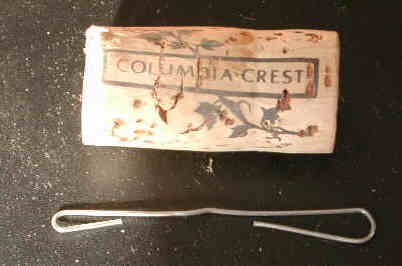| 02-25-02
QUESTION: The best way to catch
crappies in the late winter and spring is: A) small jig cast on light spinning
tackle; B) small live minnows suspended below a casting bobber with the
tackle of your choice (including long cane pole); C) a combination of A
and B (small live minnows fished on small jigs with the tackle of your
choice).
ANSWER: Any or all of the three
will do the job.
But let me tell you about another method which may beat them all.
Back in the days before somebody got filthy rich selling Geist Reservoir
residential building lots that cost less than $100 for hundreds of thousands
of dollars (through the 1950s), a young fellow called me to ask if I would
like to try his method of catching crappies.
It turned out that I would like to try the methods of this young fellow,
whose name has long since escaped my faulty cerebellum, but who had a grand
crappie-fishing game plan.
I met this young man at one of the many small bays of the reservoir
(you could fish a lot of places from the shore, or by wading in those days).
He pulled out a 7-foot spinning rod with open-faced reel loaded with
eight-pound-test monofilament line. He tied the tag end of the line to
one end of a casting bobber that he had made from a cork wine bottle stopper.
To the other end of his homemade casting bobber he tied six feet of four-pound-test
mono, and to the tag end of that line he tied a little black jig that would
have been no heftier than 1/16 (one-sixteenth) of an ounce.
Explaining his method, he told me that with the eight-pound-test mono,
he could not cast that small jig much more than 10 or 15 feet if he were
lucky. But with his rig, he could cast that jig 60 or 70 yards without
much effort
The idea, he said, was to wade the shallow bays and whip the water to
a rich, creamy lather by casting great distances and in all directions
while searching for schools of crappies.
The theory was that the weight of the casting bobber, which would float,
would carry the light jig an infinitely great distance, but that a slow
retrieve would allow the jig to run at varying depths down to six feet,
depending upon the speed of the retrieve.
When he started reeling in crappies, I bought the system lock, stock
and barrel. And soon, with one of his homemade casting bobbers, he
had me hauling out crappies with regularity.
Even with my mental incapabilities, it did not take long for me to realize
that the crux of his system rested in the fact that he could cast great
distances while presenting a lure that might just have well been fished
with a fly rod, and cover more water in the search for moving schools of
crappies.
I couldn't wait to get home, find a wine-bottle cork, and get going
with the project. As the innovative, young angler suggested, I drilled
a 1/8 (one-eighth) inch hole smack through the center of the cork (fore
to aft). Then I cut a piece of copper wire twice the length of the cork
and bent it to create a "U" on each end to make the wire 1/4 (one-fourth)
inch longer than the cork. The wire was then pushed through the cork with
loops protruding at both ends.
Then two or three lead .22 rifle bullets were melted and the molten
lead was poured in the hole in one end of the cork after stopping up the
other end with plastic tape. This was designed to give the casting bobber
more weight, but the lead must be equally distributed to avoid having a
bobber that I classify as "tipsy," (not a bad description, considering
the materials used}.
Once the lead has cooled (Elmer's waterproof glue is not a bad substitute,
and it will not burn your pinkies), the bobber can be tested in a small
container of water for "tipsy tendencies." The cork can be shaved with
a razor blade, or very sharp knife, and sanded to round off the fore end
and correct balance, or the lack thereof. This will eliminate some of the
disturbance the bobber will create as it is retrieved on the water's surface.
However, the bobber will always create a certain amount of disturbance
on the surface and show-off bass will occasionally take a whack at it.
Thus, it is not a bad idea to attach a hook (even a double or treble hook)
to the back eye of the bobber. That'll fix 'em.
 This
wine bottle cork is about 1 3/4 (one and three-fourths) inches long . .
. combined with a paper clip or wire it becomes a great casting bobber. This
wine bottle cork is about 1 3/4 (one and three-fourths) inches long . .
. combined with a paper clip or wire it becomes a great casting bobber. |
(NOTE: Why the author was able to find a wine bottle cork with
such great ease is a DNAAT (do not ask about that).
NEXT WEEK: Indiana's top crappie
waters.
|

